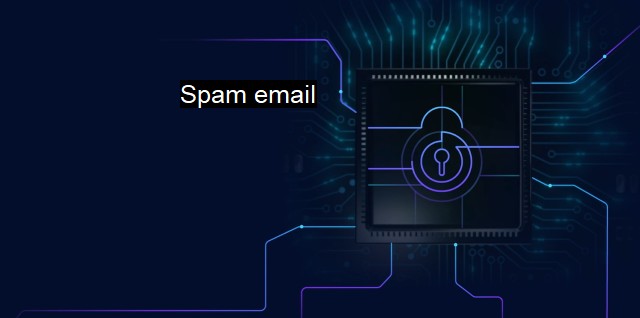What is Spam email?
The Menace of Spam Emails in Today's Cybersecurity Landscape: The Threats of Malware, Phishing, and Fraud, and How They Can Be Prevented
Spam email, often referred to simply as 'spam', refers to irrelevant or unsolicited messages sent over the Internet, typically to a large number of users, primarily for advertising, phishing, spreading malware, or other varying dubious purposes. Operating spam email emerges as a significant threat owing to its potential to compromise personal data and facilitate breaches of online security infrastructure.Spams aren't a novel phenomenon. In fact, the term 'spam' traces its origins back to a 1970 comedy sketch from Monty Python. Fast forward a few years, and with the advent of commercial Internet, this term began to represent the unsolicited, often annoying barrage of emails received by users globally.
The context of spam email in cybersecurity is highly significant, as these unwanted emails frequently contain malware, viruses, or phishing attempts which jeopardize cybersecurity. One of the most common types of spam is unwanted commercial emails, often sent by companies that may or may not be legitimate. In many cases, spam email looks genuine, mimicking authentic communications from established companies to trick users into revealing sensitive data or visiting infected websites.
Another dangerous variant of spam is 'phishing' emails. These are disguises, designed to look like they come from trustworthy sources such as banks, social networks, or online stores. The primary purpose is to deceive recipients into disclosing confidential information like credit card numbers or login credentials for different platforms, which could involve severe financial or identity theft implications.
Protection against spam emails has thus become essential. Cybersecurity efforts typically focus on preventative measures like antispam filters and phishing detection mechanisms. Modern-day antispam technology includes Bayesian filters, which learn to differentiate between spam and non-spam emails based on historical data, and DNS-based filters that verify the sender's origin to stringently mitigate spam.
In the antivirus domain, software developers channel their efforts into an ongoing war against malware-carrying spam. Sophisticated antivirus software today comes with comprehensive email scanner components, designed specifically to identify and neutralize viruses and other types of malicious software lurking in spam emails. Antivirus solutions examine incoming and outgoing emails, scan attachments, and assess email content in real-time for potential threats.
Workplace spam has also emerged as a significant concern in the cybersecurity landscape concerning spam emails. More than just junk emails infiltrating personal inboxes, these jeopardize sensitive company data and claim valuable working hours lost to unnecessary email clutter. Antispam initiatives at the corporate level typically involve deployment of robust enterprise-level security solutions paired with comprehensive employee awareness and cyber hygiene training programs.
As lurid cyber landscape threat actors continue to weave intricate deception webs taking full advantageous use of spam emails, cybersecurity and antivirus solutions are posed with a dual challenge. Ensuring data privacy and online safety becomes an incessant task in a scenario where cyber threats cleverly masked behind innocuously crafted spam emails become a frequent event.
The threats posed are diverse and ever-evolving, hence demanding an equally flexible and comprehensive response from cybersecurity professionals. Effort must be invested to keep up with the rapid development of different types of malware, phishing methods, and spam dissemination modes spanning from mass email campaigns, botnets to even personalized spear phishing.
Conclusively, spam email can be a deceptive cybersecurity threat. Its unsolicited nature harbors a plethora of potential cyber dangers and is increasingly becoming a tool used in sophisticated cyber attacks. Reorienting ourselves in this digital battlefield involves implementing and maintaining robust cybersecurity and antivirus solutions along with shifting our attitude towards a proactive, education-driven approach in managing and preventing spam email threats alike.

Spam email FAQs
What is a spam email?
A spam email is an unsolicited message sent in bulk to a large number of recipients. These emails are usually sent for commercial or malicious purposes and often contain harmful links or attachments.How can I protect myself from spam emails?
You can protect yourself from spam emails by using an email filter or spam blocker, being cautious with your email address, avoiding clicking on suspicious links or attachments, and regularly updating your antivirus software.Why do I keep receiving spam emails?
You may be receiving spam emails because your email address has been sold or shared, you have interacted with spam in the past, or your email security measures are not strong enough.What should I do if I receive a suspicious email?
If you receive a suspicious email, do not click on any links or download any attachments. Instead, report the email as spam or phishing and delete it from your inbox. If you are unsure whether an email is legitimate or not, contact the sender directly to confirm before taking any action.| | A | | | B | | | C | | | D | | | E | | | F | | | G | | | H | | | I | | | J | | | K | | | L | | | M | |
| | N | | | O | | | P | | | Q | | | R | | | S | | | T | | | U | | | V | | | W | | | X | | | Y | | | Z | |
| | 1 | | | 2 | | | 3 | | | 4 | | | 7 | | | 8 | | |||||||